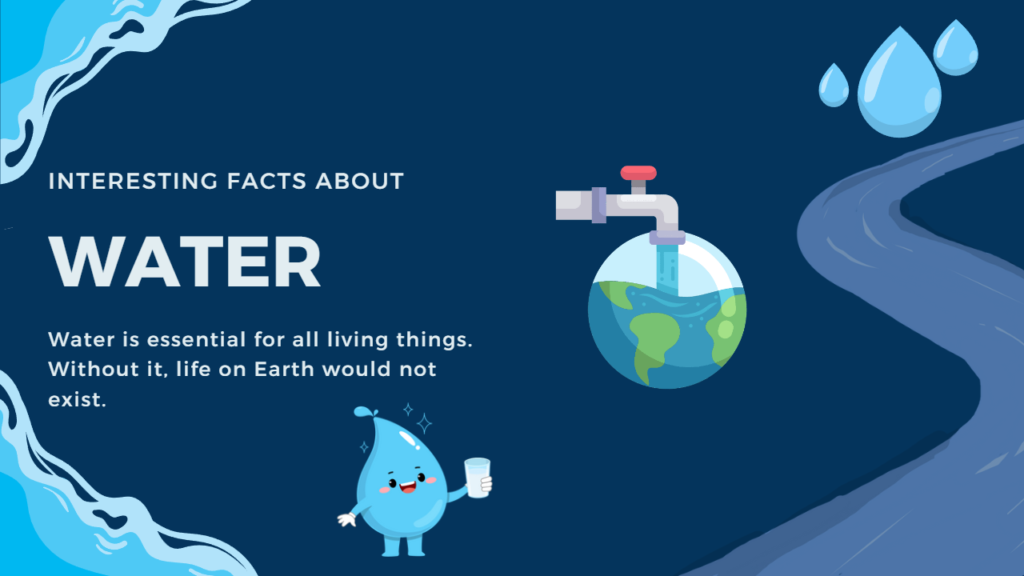Water is one of the most important components of life on Earth, and it’s no wonder why it has so many interesting facts associated with it. Here are the most fascinating facts about water that you may not have heard of:

- Water can be found in many places. It is present in the atmosphere as water vapor, in rivers and lakes on the surface, and in underground aquifers. It is also found in snow, ice, and glaciers.
- Water is an excellent conductor of heat. It takes just 4.2 joules to raise one gram of water by 1 degree Celsius, making it more effective at transferring heat than any other material, even metals. This means that if you’re looking to cool off quickly on a hot summer day, submerging yourself in a body of water is the way to go!
- Water is essential for all living things, but did you know that humans can only survive three days without drinking it? Our bodies are mostly composed of water, and getting enough of this important resource helps maintain our organs and bodily functions.
- Water can be divided into two main categories: saltwater and freshwater. Saltwater, such as that found in oceans, is denser and contains many trace elements like sodium and chloride, while freshwater is lighter and lacks these minerals.
- Small drops of water may seem insignificant, but they can be teeming with life. Each drop of ocean water is a miniature ecosystem, full of microscopic organisms and even small creatures such as fish eggs, and baby crabs. This incredible diversity of life in each droplet shows that even the smallest of spaces can contain an incredible amount of life.
- Water has a very low surface tension – meaning that it sticks together easily and creates surface tension when put in contact with solid objects, such as a glass or spoon – making it unique among liquids compared to others like oil or alcohol, which don’t exhibit the same properties. This also explains why some insects can walk on top of the water without sinking!
- Even though close to three-quarter percent (75%) of Earth’s surface is covered by oceans, lakes, and streams, only 1.2% is actually usable fresh water for drinking, sanitation, and agricultural purposes – making access to clean drinking water essential for life on our planet.
- Despite being composed mostly of two elements – hydrogen and oxygen – water still exists in three forms: liquid (in rivers/lakes/oceans), solid (ice), and gas (water vapor). This makes it one out of a few substances capable of existing in all three states simultaneously! It can change from one state to another, depending on the temperature and pressure. For example, when water is heated, it turns into a gas (water vapor) and when it is cooled, it turns into a solid (ice).
- Water freezes at 0°C (or 32°F). At this temperature, water changes from a liquid to a solid, known as freezing. This temperature is the same for all forms of water, including oceans, lakes, and rivers. Once the temperature drops below 0°C, the molecules of water slow down and form a solid structure, creating a solid block of ice.
- According to USGS estimates, the surface of the Earth is covered in 326 million trillion gallons (326 quintillion gallons) of water—enough for every person to take over 90 baths every day for the rest of their lives!
- The hydrogen atoms in each molecule of liquid H2O form covalent bonds with the oxygen atoms to form what is known as joined molecules, or “hydrogen bonds,” which contribute to the unique properties of this substance, such as freezing at temperatures well below zero degrees Celsius while remaining liquid up until then!
- The weight of a water molecule can be quite variable, depending on the number of moles present. The mass of a single water molecule is very small, but when the molecules are combined into a mole, the total weight increases. A mole of water molecules weighs 18 grams.
- The water cycle is a continuous process of water moving around the Earth. It involves five stages: evaporation, condensation, precipitation, infiltration, and surface run-off. In the first stage, evaporation, water from oceans, lakes, rivers, and other bodies of water turns into vapor and rises into the atmosphere. In the second stage, condensation, the vapor cools and forms clouds. In the third stage, precipitation, the clouds release rain, snow, hail, and other forms of moisture. In the fourth stage, infiltration, the water is absorbed into the ground and eventually makes its way into rivers, lakes, and oceans. In the fifth and final stage, surface run-off, water flows over the land and returns to the oceans, completing the cycle.
- Groundwater is a slow-moving resource that can take a very long time to travel a short distance. In fact, it can take a human lifetime for groundwater to travel just one mile. This is due to the fact that groundwater moves through porous rocks and soil, which slows its progress.
- The human body is made up of a large percentage of water. The brain is composed of 75%, the lungs 83%, the skin 64%, the muscles and kidneys 79%, and even the bones contain 31%.
- Plants have an amazing ability to absorb water from the ground and transport it upwards against the force of gravity. This process, known as transpiration, is essential for plants to survive, as it allows them to access the nutrients and moisture they need to grow and thrive.
- It is not possible for humans to consume salt water. Saltwater contains a high concentration of salt, which can be detrimental to the human body if ingested. Ingesting salt water can cause dehydration, nausea, vomiting, and other unpleasant side effects. Furthermore, the salt water does not have the necessary nutrients and minerals that the human body needs to function properly.
- After being ingested, it takes approximately five minutes for the water to leave the stomach and enter the small intestine. This process is known as gastric emptying, and it is an important part of the digestion process.
- NASA has made a groundbreaking discovery: water in the form of ice has been found on the moon. This is a significant finding, as it has been long suspected that water may exist on the moon, but until now, there was no conclusive evidence to prove it. This discovery could have major implications for future space exploration, as it could provide a source of water for astronauts and fuel for spacecraft.
- It takes 300 tons of water to produce 1 ton of steel. This water is used in the cooling process, as well as for cleaning and lubrication during the manufacturing process. The water is then recycled, treated, and reused in the process.
- Americans use an average of 5.7 billion gallons of water per day for toilet flushing alone. This is equivalent to over 6,000 Olympic-sized swimming pools and is a significant amount of water being used for this purpose.
- From 3000 BC to 2012, there have been 265 documented cases of disputes related to water resources. These conflicts range from disagreements over access and allocation to more serious disputes such as water-related violence.
- Antarctica is home to a massive amount of the world’s freshwater supply, with over 90% of the world’s freshwater found there. This is due to a large number of glaciers, ice caps, and ice sheets found in the region. The freshwater stored in these glaciers is vital to the global water cycle, as it is released into the ocean and then evaporates into the atmosphere, eventually falling as rain or snow again.
- Access to clean, fresh water is a necessary part of life that many of us take for granted. Unfortunately, the United Nations estimates that by 2025, two-thirds of the world’s population will face water scarcity. This means that millions of people will have difficulty obtaining enough water to meet their daily needs. To combat this crisis, governments and organizations must invest in infrastructure and policies that can help resolve water scarcity issues before it’s too late.
- A single acre of corn can release up to 4,000 gallons of water every day through the process of evaporation. This water is essential for the growth of the corn, and for the surrounding environment. The water evaporated from the acre of corn helps to cool the air, which in turn helps to reduce air pollution. This water also helps to replenish the local water table, which is essential for the survival of other plant and animal species in the area. In addition, water helps to reduce the amount of dust in the air, which can be harmful to human health.
Water is truly an amazing substance, so it’s no wonder that humans have such a strong connection to it. From quenching our thirsts to providing us with a way to stay cool on hot summer days, its utility is invaluable.
There are countless species throughout Earth that depend solely on freshwater ecosystems for their survival! By taking steps to conserve and protect freshwater sources, we can ensure that these unique species have a place to call home for years to come.
So next time you take a sip of water, remember all the amazing things it can do for us and our planet!





